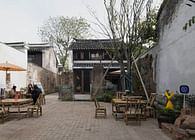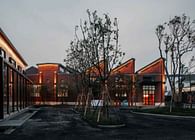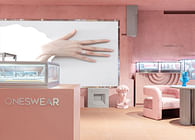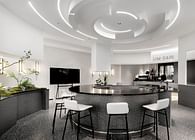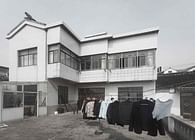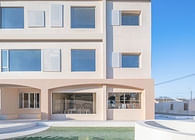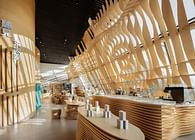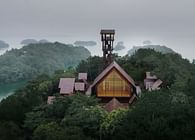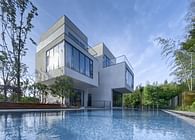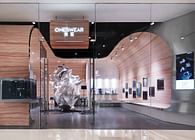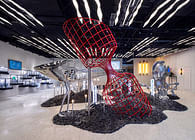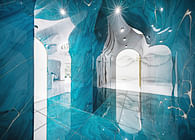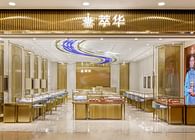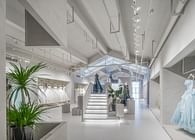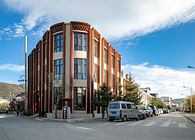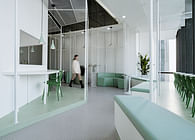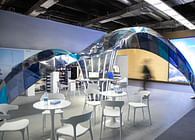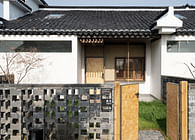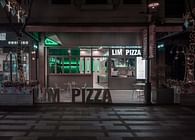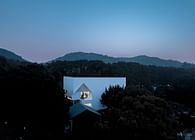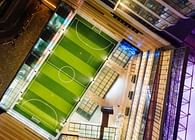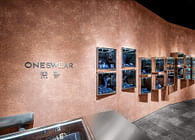
The project is located at Jiuhua Road, Suzhou Industrial Park, Jiangsu Province, and is located in the living center of several residential areas. The original store is chicken rice / barbecue restaurant . The facing street shop is very small and narrow. The facade of the space is high but narrow, and the interior space is also an extremely narrow "alley" space, about 13 meters long and 2.3 meters wide, with an area of about 30 square meters. The new restaurant is an emerging abalone rice restaurant. The manager hopes to transform the interior and exterior to create a unique experience to attract the flow of people around the area, making the store a “pop-up restaurant” that everyone wants to eat and take photos, which also help with his follow-up take-away business.
Therefore, how to use the narrow space to create a “pop-up restaurant” dining space has become the core issue of this design, and the extremely low budget is also a design obstacle that needs to be overcome. There are three key points that can be clarified: First, it is necessary to make reasonable use of the narrow and long form features of the space, and reasonably arrange the tables and chairs; secondly, the space should looks spacious and not depressed by using material and light; third, the facade and interior should attract people to come but also with certain visual impact to create a "fast" psychological effect to push people eat quickly in this space in order to control the crowd flow.
Through taste of the dishes and chat with the chef, the designer gradually formed the design concept of taste/time tunnel: by installing horizontal stripes on the enclosed wall and top surface in order to increase the variety and richness of the wall to make the fleeting effect of interior space. Three combinations of two materials - wood strip and LED light, are used to emphasize the fleeting speed, while emphasizing the "tunnel" feeling with infinite extension to the food.
In order to satisfy a better dining experience and increase the lateral width of the spatial feeling. Under the condition of limited costs, the designer abandoned the use of mirrored materials and tried to use the cheaper epoxy paint on the wall to create a spatial interface of reflection and illuminance. The diffuse reflection brought a texture similar to matte and did not make the light reflect too strongly which cause uncomfortable. At the same time, the functional surface such as counter, the window of kitchen uses mirrored acrylic to make the space form a mirror-reflective effect while enhancing the depth of the space.
Thus, a complete diffuse channel space came into being. The overall design space is divided into two parts: the reception space and the dining area space. The counter only uses a computer as the interface on the desk to negotiate with the clerk and the customer, other functions are hidden under the white table-board. At the same time, the movable design of the counter partially meets the needs of the clerk to enter and exit, and the partial waiting space left at the counter is for the take-away staff to rest.
The dining space is divided into two types of tables and chairs according to different eating modes. The wooden strips and LED light are inlaid on the left and right walls with gradually change form according to lighting requirements are reduced from top to bottom. The light bar enhances the depth of the space and adds a sense of fashion and fun. The combination of wooden floor and strips create the continuity of the spatial interface and increases the intimacy and warm-feeling of the space.
The entire space is made up of several materials' “collage”, which eliminates the logic of traditional design logic of ceilings, walls and floors. The interior space is mainly made of four materials: epoxy paint, wood strips, light strips, and mirror acrylic. The mirrored acrylic is mounted at the end of the narrow space and functions as extension of space. The epoxy resin paint has the function of diffuse reflection, and serves as the main base material for the walls and the top surface, giving the interface a glossy texture and making the space visually wider. Wood strips and light strips perform three different wall operations: pure wood strips, pure light strips, and wooden strips with built-in strips (an effect suspended in the air). The end of the space is not only terminated with an eye-catching extension interface, but also begins to re-direct the dining atmosphere of the entire space with the food outlet (taste and smell).
Corresponding to the indoor space, the façade also continues a similar vocabulary, using cheap metal mesh for as base, install light strips and wooden strips on the surface with easy bolts. The upper and lower sign were completely separated in the previous use, and the middle two-storey space is also used by other stores. Therefore, the facade design has connected both parts and overcomes the obstructed issues of upper store.Located at a residential area determines that it is difficult to have the characteristics of a pop-up restaurant compared with in a commercial district. But its unique narrow space, it work as a "neighborhood cafe" to describe its position. Designers also hope this space can serve as a new paradigm for the superposition of pop-up store and fast food culture in China. The role of design in this space is not to cater to business, but to re-express and reflect and reinterpret small dinning space.
Status: Built
Location: Suzhou, CN
Additional Credits: Engineering: Shanghai hengtai architectural design consulting co., LTD
Photo: Jieqi.Yao








